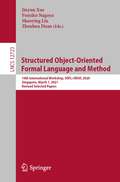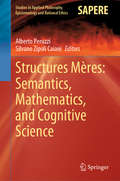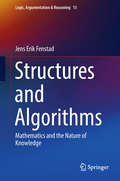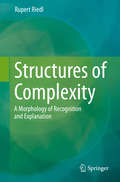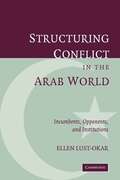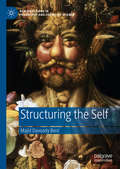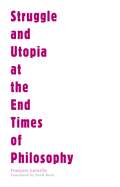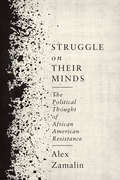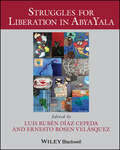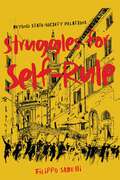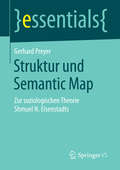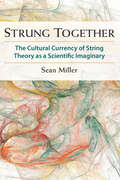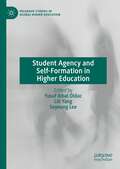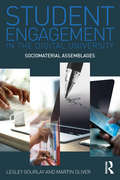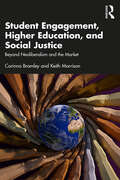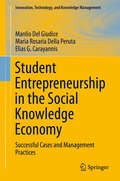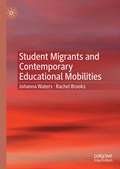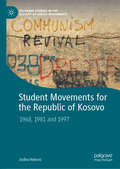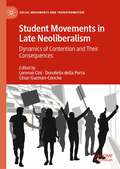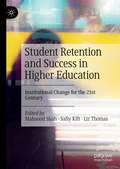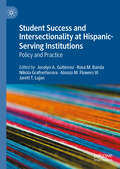- Table View
- List View
Structured Object-Oriented Formal Language and Method: 10th International Workshop, SOFL+MSVL 2020, Singapore, March 1, 2021, Revised Selected Papers (Lecture Notes in Computer Science #12723)
by Shaoying Liu Zhenhua Duan Jinyun Xue Fumiko NagoyaThis book constitutes the refereed workshop proceedings of the 10th International Workshop on Structured Object-Oriented Formal Language and Method, SOFL+MSVL 2020, held in Singapore, in March 2021. The 13 revised full papers included in the volume were carefully reviewed and selected from 24 submissions. They are organized in the following topical sections: modeling and specification; model checking; specification and verification; and testing and formal verification.Due to the Corona pandemic this event was held virtually.
Structures Mères: Semantics, Mathematics, and Cognitive Science (Studies in Applied Philosophy, Epistemology and Rational Ethics #57)
by Alberto Peruzzi Silvano Zipoli CaianiThis book reports on cutting-edge concepts related to Bourbaki’s notion of structures mères. It merges perspectives from logic, philosophy, linguistics and cognitive science, suggesting how they can be combined with Bourbaki’s mathematical structuralism in order to solve foundational, ontological and epistemological problems using a novel category-theoretic approach. By offering a comprehensive account of Bourbaki’s structuralism and answers to several important questions that have arisen in connection with it, the book provides readers with a unique source of information and inspiration for future research on this topic.
Structures and Algorithms: Mathematics And The Nature Of Knowledge (Logic, Argumentation And Reasoning Ser. #15)
by Jens Erik FenstadThis book explains exactly what human knowledge is. The key concepts in this book are structures and algorithms, i.e., what the readers “see” and how they make use of what they see. Thus in comparison with some other books on the philosophy (or methodology) of science, which employ a syntactic approach, the author’s approach is model theoretic or structural. Properly understood, it extends the current art and science of mathematical modeling to all fields of knowledge. The link between structure and algorithms is mathematics. But viewing “mathematics” as such a link is not exactly what readers most likely learned in school; thus, the task of this book is to explain what “mathematics” should actually mean. Chapter 1, an introductory essay, presents a general analysis of structures, algorithms and how they are to be linked. Several examples from the natural and social sciences, and from the history of knowledge, are provided in Chapters 2–6. In turn, Chapters 7 and 8 extend the analysis to include language and the mind. Structures are what the readers see. And, as abstract cultural objects, they can almost always be seen in many different ways. But certain structures, such as natural numbers and the basic theory of grammar, seem to have an absolute character. Any theory of knowledge grounded in human culture must explain how this is possible. The author’s analysis of this cultural invariance, combining insights from evolutionary theory and neuroscience, is presented in the book’s closing chapter. The book will be of interest to researchers, students and those outside academia who seek a deeper understanding of knowledge in our present-day society.
Structures of Complexity: A Morphology of Recognition and Explanation
by Rupert RiedlIn this book, the author Rupert Riedl investigates the structural and functional correlations of issues considered as "complex". He brilliantly analyzes the definition of complexity, the occurrence of complexity, the meaning of complexity, and last-but-not-least the way complexity is dealt with professionally.In recent years, our view of the world has been split into ever smaller segments – in part due to the increasing importance of the natural sciences and their associated analytical power. This calls for once again focusing on complexity and the holistic aspects, on interdisciplinary and synoptic approaches. This book is a translation of the original German version “Strukturen der Komplexität”, which was published in 2000. The discussion of complexity from the perspective of a biologist has long been overdue when it was published and is still up-to-date.
Structuring Conflict In The Arab World: Incumbents, Opponents, And Institutions
by Ellen Lust-OkarThis book examines how ruling elites manage and manipulate their political opposition in the Middle East. In contrast to discussions of government-opposition relations that focus on how rulers either punish or co-opt opponents, this book focuses on the effect of institutional rules governing the opposition. It argues rules determining who is and is not allowed to participate in the formal political arena affect not only the relationships between opponents and the state, but also between various opposition groups. This affects the dynamics of opposition during prolonged economic crises. It also shapes the informal strategies that ruling elites use toward opponents. The argument is presented using a formal model of government-opposition relations. It is demonstrated in the cases of Egypt under Presidents Nasir, Sadat and Mubarek; Jordan under King Husayn; and Morocco under King Hasan II.
Structuring the Self (New Directions in Philosophy and Cognitive Science)
by Majid Davoody BeniThis book presents a unified account of the self, based on a network of knowledge sourced from several scientific accounts of selfhood. Beni constructs his ontological account of the self from the common structure that underpins the theoretical diversity that is manifested in rival and sometimes incompatible scientific accounts of the self and its aspects. The enterprise is inspired by recent structural realist theories in the philosophy of science, specifying the basic structure of the self, and explaining how representational, phenomenal, and social aspects of the self are embodied within this structure.
Struggle and Utopia at the End Times of Philosophy (Univocal)
by François LaruelleVery few thinkers have traveled the heretical path that François Laruelle walks between philosophy and non-philosophy. For Laruelle, the future of philosophy is problematic, but a mutation of its functions is possible. Up until now, philosophy has merely been a utopia concerned with the past and only provided the services of its conservation. We must introduce a rigorous and nonimaginary practice of a utopia in action, a philo-fiction—a close relative to science fiction. From here we can see the double meaning of the watchword, a tabula rasa of the future. This new destination is imposed by a specifically human messianism, an eschatology within the limits of the Man-in-person as antihumanist ultimatum addressed to the History of Philosophy. This book elucidates some of the fundamental problems of non-philosophy and takes on its detractors.
Struggle on Their Minds: The Political Thought of African American Resistance
by Alex ZamalinAmerican political thought has been shaped by those who fought back against social inequality, economic exclusion, the denial of political representation, and slavery, the country's original sin. Yet too often the voices of African American resistance have been neglected, silenced, or forgotten. In this timely book, Alex Zamalin considers key moments of resistance to demonstrate its current and future necessity, focusing on five activists across two centuries who fought to foreground slavery and racial injustice in American political discourse. Struggle on Their Minds shows how the core values of the American political tradition have been continually challenged—and strengthened—by antiracist resistance, creating a rich legacy of African American political thought that is an invaluable component of contemporary struggles for racial justice.Zamalin looks at the language and concepts put forward by the abolitionists David Walker and Frederick Douglass, the antilynching activist Ida B. Wells, the Black Panther Party organizer Huey Newton, and the prison abolitionist Angela Davis. Each helped revise and transform ideas about power, justice, community, action, and the role of emotion in political action. Their thought encouraged abolitionists to call for the eradication of slavery, black journalists to chastise American institutions for their indifference to lynching, and black radicals to police the police and to condemn racial injustice in the American prison system. Taken together, these movements pushed political theory forward, offering new language and concepts to sustain democracy in tense times. Struggle on Their Minds is a critical text for our contemporary moment, showing how the political thought that comes out of resistance can energize the practice of democratic citizenship and ultimately help address the prevailing problem of racial injustice.
Struggles for Liberation in Abya Yala
by Luis Rubén Díaz Cepeda Ernesto Rosen VelásquezPresents struggles for liberation in the Americas from the perspectives of structural victims Struggles for Liberation in Abya Yala explores the ways people occupying different positionalities respond to various catastrophes while discussing how collective processes of struggle make new meanings and create new forms of relationality and subjectivity. Bringing together contributions by a diverse panel of well-established voices and rising scholars, this provocative volume challenges readers to resist, take direct collective action, organize, protest, and give proper uptake to social movements that fight against injustice and life-threatening conditions. Operating primarily within the context of “Abya Yala” — the term deployed by indigenous peoples to refer to the US, Latin America, and the Caribbean — the volume demonstrates and advances the explanatory and normative power of Philosophy of Liberation and the Decolonial Turn through theoretical analysis of current social changes unfolding in the Americas. Throughout the book, academic scholars and on-the-ground activists illustrate the reach, impact, and implications of radical social transformations that support victims of the system. Offering perspectives from the people who have chosen to rebel and act in solidarity against the system that oppresses them, Struggles for Liberation in Abya Yala: Addresses different struggles for social justice in the US, México and Latin America Draws from philosophical tradition with influence in Africana philosophy, feminism, critical race theory, ethics, and political philosophy Tasks readers to fight for reparations, stand in solidarity with marginalized and indigenous peoples, and abolish dispossession Critiques the capitalist and colonial relationships that facilitate the exploitation of large segments of the population Promotes social mobilization through education and the decolonization of Westernized university and educational practices An urgent call to action for all those seeking to fundamentally change the world, Struggles for Liberation in Abya Yala is a must-read for undergraduate and graduate students, educators and university lecturers, academic researchers and scholars, social and political activists, policymakers, journalists and media professionals, and general readers who are committed to liberation.
Struggles for Self-Rule: Beyond State–Society Relations (McGill-Queen's Studies in the History of Ideas)
by Filippo SabettiPeople the world over aspire to self-rule, especially when living under domination, conquest, and empire. Inspired by the work of Nobel laureate Elinor Ostrom, Filippo Sabetti explores how people attempt, over time, to make the longing for self-government a reality.Struggles for Self-Rule explores key moments in Italian history through a comparative perspective – from the city republics to the challenge of self-rule in France, Spain, and Catalonia – to study the circumstances in which people are able to take control of decisions that affect their lives and to what extent. Sabetti shows the wealth of the human experience of self-rule when we shift the focus of research from the government to the governance of public affairs.Traversing history, philosophy, comparative politics, and sociology, Struggles for Self-Rule takes the reader on a renaissance tour of the history of ideas and self-government that resonates in today’s world, when many communities struggle to shape the decisions that affect their lives.
Struggling with God: Kierkegaard and the Temptation of Spiritual Trial
by Simon D PodmoreInvoking the biblical motif of Jacob's struggle with the Face of God (Genesis 32), Simon D. Podmore undertakes a constructive theological account of 'spiritual trial' (tentatio; known in German mystical and Lutheran tradition as Anfechtung) in relation to enduring questions of the otherness and hiddenness of God and the self, the problem of suffering and evil, the freedom of Spirit, and the anxious relationship between temptation and ordeal, fear and desire. This book traces a genealogy of spiritual trial from medieval German mystical theology, through Lutheran and Pietistic thought (Tauler; Luther; Arndt; Boehme), and reconstructs Kierkegaard's innovative yet under-examined recovery of the category (AnfAegtelse: a Danish cognate for Anfechtung) within the modern context of the 'spiritless' decline of Christendom. Developing the relationship between struggle (Anfechtung) and release (Gelassenheit), Podmore proposes a Kierkegaardian theology of spiritual trial which elaborates the kenosis of the self before God in terms of Spirit's restless longing to rest transparently in God. Offering an original rehabilitation of the temptation of spiritual trial, this book strives for a renewed theological hermeneutic which speaks to the enduring human struggle to realise the unchanging love of God in the face of spiritual darkness.
Struktur und Semantic Map: Zur soziologischen Theorie Shmuel N. Eisenstadts (essentials)
by Gerhard PreyerGerhard Preyer rekonstruiert in diesem essential den harten Kern von Shmuel N. Eisenstadts allgemeiner Soziologie, wie Eisenstadt sie in der Untersuchung der Beziehung zwischen Handeln (Kreativit#65533;t) und Struktur sowie zwischen Kultur und Sozialstruktur durchgef#65533;hrt hat. Preyer ordnet seine Untersuchung in dem von ihm sogenannten ,,semantischen Map" als eine evolution#65533;re Universalie des ,,konstitutiven basalen Bezugsrahmens" der Erforschung der sozio-strukturellen Evolution an. Aus Eisenstadts Sicht legen die grundlegenden semantischen Maps das zentrale Problem der menschlichen und der sozialen Existenz, die Spezifikation ihrer L#65533;sungen und die Beziehung zu den grundlegenden Annahmen #65533;ber die soziale Ordnung fest. Das Semantic Map und der Kampf um die Verteilung von Ressourcen ist der forschungsprogrammatische Bezugsrahmen seiner Reformulierung der Modernisierungstheorie, der Kritik an der klassischen Modernisierungstheorie als einer Konvergenztheorie und seiner Fassung des Problems der sozialen Ordnung. Die Studie wird mit einer Modifikation von Eisenstadts Ansatz einer mitgliedschaftstheoretischen Reinterpretation abgeschlossen.
Strung Together: The Cultural Currency of String Theory as a Scientific Imaginary
by Sean MillerIn Strung Together: The Cultural Currency of String Theory as a Scientific Imaginary, Sean Miller examines the cultural currency of string theory, both as part of scientific discourse and beyond it. He demonstrates that the imaginative component of string theory is both integral and indispensable to it as a scientific discourse. While mathematical arguments provide precise prompts for physical intervention in the world, the imaginary that supplements mathematical argument within string theory technical discourse allows theorists to imagine themselves interacting with the cosmos as an abstract space in such a way that strings and branes as phenomena become substantiated and legitimized. And it is precisely this sort of imaginary--which Miller calls a scientific imaginary--duly substantiated and acculturated, that survives the move from string theory technical discourse to popularizations and ultimately to popular and literary discourses. In effect, a string theory imaginary legitimizes the science itself and helps to facilitate a virtual domestication of a cosmos that was heretofore remote, alien, and incomprehensible.
Student Activism in 1960s America: Stories from Queens College (Palgrave Studies in the History of Social Movements)
by Magnus O. BasseyThis book sheds light on the untold stories of individual student activists at Queens College, New York City, during the 1960s. Against the backdrop of the ongoing Vietnam War and the assassination of President John F. Kennedy, some Americans began to lose faith in their government. Based on injustices that students saw in their campuses, in the country, and in the world at large, they began to question their political leaders. Students organized their discontents over three major issues: civil rights, free speech, and anti-war sentiments. Their protests involved direct actions such as sit-ins, marches, picketing, and boycotts. At Queens College (QC), as the students moved away from the repressive McCarthy era of the 1950s, they began to confront and challenge those in power at the college in the 1960s. The defining characteristic of this break from the past was a student strike in 1961 in objection to the ban of controversial speakers who had been invited to campus by student clubs. The student strike of 1961 gave the activists among them a direct and immediate way to fight power on campus and to fight racism and discrimination. The author argues that student movements cannot be attributed to a single explanation, and therefore, he focuses on individual historical contexts, presenting first-person narratives from the actual participants, and tells their stories in their own voices, from their own records, and from the documents they left behind. The book identifies the QC student activists of the 1960s, exploring how and why they became activists; their activities; their achievement as activists; and what motivated them to think that they could make history themselves by confronting racism. It provides an intimate look at the students’ lives and their social justice journey, beginning at Queens College and as they moved into their careers.
Student Activism in the Global South: The Formation of Political Capabilities in Higher Education
by Kurauone MasungoThis book makes an original conceptual and empirical contribution to debates on the role of student activism in enhancing social justice within education in the Global South, using South Africa as a case study. The book explores the development of higher education students’ political capabilities through student activism – that is, the freedom to express political ideas and engage in protests, including the following key capabilities: participation, dialogue, practical reasoning, voice, emotional expression, contextual knowledge and physical wellbeing. The author considers the possibility of enhancing justice and democracy in higher education through the formation of such student freedoms. The book will be of interest to academics and researchers in student activism, higher education and social justice, as well as institutional staff members with knowledge of student governance, members of student representative councils and higher education administrators.
Student Agency and Self-Formation in Higher Education (Palgrave Studies in Global Higher Education)
by Lili Yang Soyoung Lee Yusuf Ikbal OldacThis edited volume argues for positioning students at the centre of higher education, drawing from the concepts of student agency and self-formation. The volume highlights that higher education has broader and more important purposes than what a neoliberal human capital approach would suggest, and explores how students exercise their agency and realise self-formation as inherently connected concepts throughout university education. With disciplinary, cultural, and contextual diversity, this volume will provide international perspectives to readers interested in higher education theories, policies, and practices.
Student Engagement in the Digital University: Sociomaterial Assemblages
by Martin Oliver Lesley GourlayStudent Engagement in the Digital University challenges mainstream conceptions and assumptions about students’ engagement with digital resources in Higher Education. While engagement in online learning environments is often reduced to sets of transferable skills or typological categories, the authors propose that these experiences must be understood as embodied, socially situated, and taking place in complex networks of human and nonhuman actors. Using empirical data from a JISC-funded project on digital literacies, this book performs a sociomaterial analysis of student–technology interactions, complicating the optimistic and utopian narratives surrounding technology and education today and positing far-reaching implications for research, policy and practice.
Student Engagement, Higher Education, and Social Justice: Beyond Neoliberalism and the Market
by Keith Morrison Corinna BramleyStudent engagement is a catch-all term, irresistible to educators and policy makers, and serving many agendas and purposes. This ground-breaking book provides a powerful theory of student engagement, rooted in critical theory and social justice. It sets out a compelling argument for student engagement to promote social justice and to repel neoliberalism in, and through, higher education, addressing three key questions: Student engagement in what? Student engagement for what? Student engagement for whom? The answers draw on Habermas, Honneth, Gramsci, Foucault, and Giroux in examining ideology, power, recognition, resistance, and student engagement, with examples drawn from across the world. It sets out key features, limitations, and failures of neoliberalism in higher education, and indicates how student engagement can resist it. Student engagement calls for higher education institutions to be sites for challenge, debate on values and power, action for social justice, and for students to engage in the struggle to resist neoliberalism, taking action to promote social justice, democracy, and the public good. This book is essential reading for educators, researchers, managers and students in higher education, social scientists, and social theorists. It is a call to reawaken higher education for social justice, human rights, democracy, and freedoms.
Student Entrepreneurship in the Social Knowledge Economy
by Maria Rosaria Della Peruta Manlio Del Giudice Elias G. CarayannisTraditionally, the study of entrepreneurial behavior focuses on such factors as (i) the personality characteristics that distinguish the entrepreneur from non-entrepreneur and (ii) demographic characteristics such gender, age, familiar antecedents and education. With particular respect to investigating the development, acquisition, and dissemination of entrepreneurial skills and behaviors, the authors focus on the university environment, as a locus of research and innovation, where students are exposed to a wide variety of influences that are enhanced by a high degree of connectivity. The underlying theme of this volume is to develop our understanding of the sociology of student entrepreneurial behavior and in doing so attempt to synthesize literature investigating individual talent with the literature on concurrent knowledge sourcing in the pursuit of entrepreneurial activities. Specifically, the authors investigate the degree to which access to diverse knowledge (in addition to such psychological characteristics and tolerance of ambiguity and risk taking) influences the nature and probability of entrepreneurial success. Moreover, they explore the role of social media and social networking in facilitating access to distributed and disparate information and knowledge Their research addresses such timely questions as: Where do entrepreneurial opportunities come from? How can higher education best stimulate the creation of firms emanating from young and smart minds in colleges and universities? What is the value of MOOCs for frequent, early, and "thick" communication among the various specialties needed to accomplish entrepreneurial projects? How do we know whether social media affect students' responses to new knowledge and new ideas? To what extent do educational practices affect racial and ethnic differences in student entrepreneurship? What is the role of the indigenous minority student entrepreneur in establishing high-technology firms? The result is a multi-dimensional approach that sheds light on the dynamics of education, knowledge creation, social networking, innovation and new business development.
Student Migrants and Contemporary Educational Mobilities
by Rachel Brooks Johanna WatersThis book explores questions around the meaning and significance of international student migration. Framed in relation to the mobilities – and immobilities – of international students, the book highlights various key themes emerging from the rich interdisciplinary scholarship in this area, including socio-economic diversification in mobile students, the differential value of international higher education, and citizenship and state-building projects. It also discusses the importance of considering ethics in relation to student migrants. This pioneering book will be of interest and value to scholars of student mobilities and the international student experience more widely, as well as practitioners and policy makers.
Student Movements for the Republic of Kosovo: 1968, 1981 and 1997 (Palgrave Studies in the History of Social Movements)
by Atdhe HetemiThis book analyzes the central vision of three student movements organized by different generations of Kosovo Albanian students in 1968, 1981 and 1997. By examining the dynamics of the demonstrations, the author explores the dimensions, forms and implications of student uprisings and resistance, as well as the struggles for dominance by local (Kosovo), federal (SFRY), regional (Albania and Serbia) and international actors (outside the Balkans). While these demonstrations were organized by students, the book shows that these were not necessarily academic but political, highlighting the impact that students had on society to demonstrate. It examines how the vision for “Republic” status or independence impacted the first and subsequent student movements. Moreover, due to the richness of the empirical data included, this book contributes toward further discussions on social movements, nationalism and state theories.
Student Movements in Late Neoliberalism: Dynamics of Contention and Their Consequences (Social Movements and Transformation)
by Donatella Della Porta Lorenzo Cini César Guzmán-ConchaThis book inquires into the global wave of student mobilizations that have arisen in the aftermath of the economic crisis of 2008, accounting for their historical and sociological significance. More specifically, its eleven chapters explore the role of students as political actors: their ability to build effective organizations, to make political alliances with other actors, and to win public consensus, as well as their impact on cultural, political, and policy outcomes. To do so, the volume examines case studies in England, Chile, South Africa, Quebec, and Hong Kong, covering Europe, Africa, Asia, and North and Latin America. Grouped into two major sections, the collection covers the organizational structures of student movements and their alliances and outcomes. Ultimately, this volume examines the understudied political aspects of student unrest, exploring how student mobilizations—driven by indebtedness, precariousness, the corporatization of the university, and other issues—correspond to larger processes of change with wider implications in society.
Student Resistance to Dictatorship in Chile, 1973-1990: 'Security to Study, Freedom to Live!' (Palgrave Studies in the History of Social Movements)
by Richard G. SmithThis book documents and analyses Chilean university and school students’ opposition to the Pinochet regime during the latter years of the 1970s and the 1980s. The book focuses on key episodes such as the establishment of cultural groups within the militarily controlled universities that enabled students to congregate and exchange ideas for the first time since the 1973 coup; how university and secondary school students created their own democratic institutions to challenge the regime-appointed bodies; and how these eventually led to the restoration of the national federations that had been banned by the military government. The author explores the key relationship between the vertically organised, underground political parties, and the horizontally organised, broad, non-partisan organisations created by the students, arguing that this structure brought advantages to the movement. The students’ contribution to the national protests in the 1980s ensured that opposition to the regime was highly visible in the city centre, resulting in a socially broadened opposition with a focus on youth, rather than disenfranchisement and poverty. Offering a detailed account of different forms of student activism, this book evaluates the role of school and university students within the broader anti-dictatorship opposition in Chile.
Student Retention and Success in Higher Education: Institutional Change for the 21st Century
by Mahsood Shah Liz Thomas Sally KiftThis book draws together international research to assess the quality of successful efforts to retain students. The editors and contributors unite diverse global research from countries who have led student retention and success projects at national, institutional, faculty or program level with positive outcomes. The book is underpinned by the philosophy that a more diverse student population requires higher education institutions to fundamentally change, in order to facilitate the success of all students. All of humanity, its economies and societies, are being pummelled by waves of pandemic-induced crises in tandem with globalisation and demographic shifts. Ultimately, this book acts as a clarion to higher education institutions to better support and retain their students, in order to create a more stable learning environment.
Student Success and Intersectionality at Hispanic-Serving Institutions: Policy and Practice
by Rosa M. Banda Jocelyn A. Gutierrez Nikola Grafnetterova Alonzo M. Flowers III Jarett T. LujanWith the influx of Hispanic-Serving Institutions (HSIs) on the landscape of higher education, it has become apparent that institutional policy, practices, and procedures for student success must be understood from an empirical and practitioner standpoint. This edited book offers current scholar/practitioners the opportunity to evidence empirical-based strategies and practices at HSIs relating to student success.
